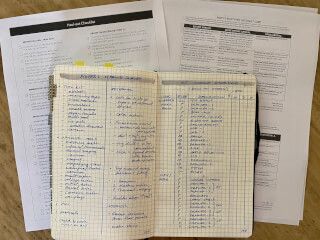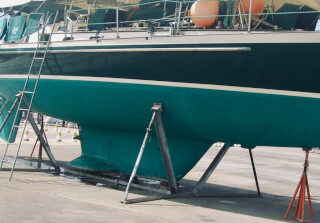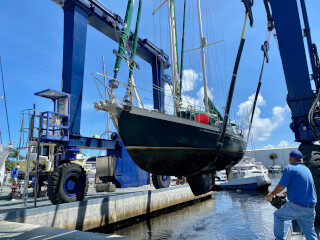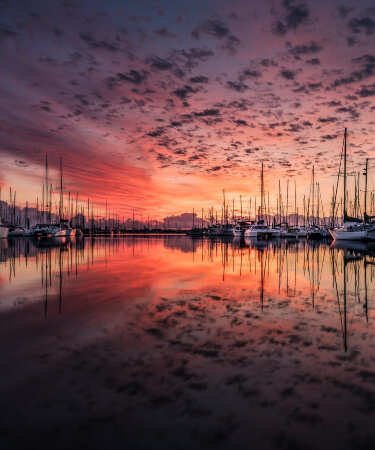Table of Contents

Self-sufficiency
One morning in early August, Andrew and I were discussing upcoming travel including the Ft Lauderdale trip. He admitted aloud that he hadn’t spent any time thinking through what to expect.
Generally, his preference when approaching anything new is to figure things out himself rather than rely too much on the opinions of others. He threw his iPhone onto the bed,
“Imagine we don’t have any access to Google. Bill has circled the drain, and we need to figure this out for ourselves. What are you going to do?”
I shrugged.
In my mind, I didn’t think this mystery needed belaboring, but I understood his point. Andrew was taking every step of this process seriously. I took on faith what Bill had said in July. Bill has a history of sparing no cost when it comes to maintaining his boat over 30 years. He recommended using Interlux Micron 66 for the bottom paint. That was good enough for me.
Andrew absorbed this recommendation and then spent hours researching bottom paint performance. He started with the knowledge that Micron 66 is what’s on the bottom now and by reading through write-ups from Jamestown Distributor including Interlux Micron 66, which was Bill’s recommendation and Sea Hawk Cukote, which was the boatyard’s recommendation given that RJ Slocum had been sitting in water with lower salinity. We then had a follow-up call with Bill on the topic along with finalizing the travel plans in September.

Preparing for a Haul Out
Before we arrived in Florida, we did some research and found some useful links on the topic:
- Passage Maker - a haul out game plan is helpful for owners who would like to diagnose issues through a mechanical test run prior to the haul out so they can tackle areas that require servicing once the boat is out of the water
- Mahina Expeditions - article of what to do when decommissioning and recommissioning in a foreign port
- Commuter Cruiser - provides a reference for a quick haul out
- Sailing Totem - chronicled their 6th haul out while they are in Mexico
- The Boat Galley - offers tips for hauling out your boat
It’s also important to take care to understand the details of the arrangements with the boatyard, i.e., scope and cost. For example, you may want to ask the following questions of the yard when they are preparing a quote:
- How long bewteen coats of bottom paint and how long between the last coat and launch?
- How much more would you charge to buff and wax the hullsides?
- Will your crew clean my boat after launch and how long will it take?
- What warranty do you place on your work?
- How many days will you give me to complete my projects (if you are doing work)?
Finally, on splash day, check the work and talk to the yard about the work performed. Review the itemized invoice and check it against the estimate. Pay the bill and tip the workers. Compare the boat’s condition (pre-haul and post-haul list and photos). Check the rigging.

Choosing Antifoul
Choosing the right antifoul for your boat depends on a number of variables: water temperature, oxygenation levels, salinity, current or movement, how much you sail and at what speed, hull material, etc. Its performance also depends on how it is applied and the integrity of the layers of coats underneath.
In addition to Antifouling Paint Test Report 2015, we also referenced:
- Bottom Paint Test Report - Practical Sailor examines antifouling paints after 1-year and 2-year in-water tests as 72 new paint panels are submerged in the Florida Keys and Long Island Sound. These test panels are pulled and examined for their resistance to hard growth and soft growth. Their detailed charts provide results for ablative paints, hard paints and specialty paints. The lineup of paints includes several low-copper and no-copper paints, as sailors look for viable alternatives to metal-based paints.
- Effectiveness of Anti-fouling Coatings in Southwest Florida - This study’s goal was to compare eight commercially available anti-fouling coatings at three RECON stations (Redfish Pass, Gulf of Mexico and Shell Point). At all locations, PVC frames holding six plates (each ~10.2cm²) with various treatments were deployed. At the RECON sites, plates were deployed for four months and sampled monthly using digital photography. Plate images were analyzed using image analysis software Coral Point Count, for percent cover of organisms such as biofilm and barnacles.

Opinions from Cruisers
In our specific use case, we wanted to know whether it would be disasterous slapping on a few coats of Micron 66 at this point, and so I posed the following question to the Women Who Sail:
In a couple weeks, we will be doing a pre-purchase survey and sea trial on this beauty.
Currently, she is docked in New River (Ft Lauderdale, FL, USA) which has low levels of salinity. We were originally going to apply more coats of Micron 66 but we were told that another brand was better suited to low salinity. Our plan is not to keep her there beyond hurricane season. Our intended destination is to head to the Caribbean.
So if we were to continue with Micron 66, does anyone have any experience with how it will respond in locations with low salinity?
Appreciate any insights! 🙏
Some responses mentioned having a great experience with Pettit Trinidad Pro and a couple echoed our presumption, which was to stick with Micron 66.
Suky Cannon (who has a USCG Master Mariner 100 Ton License and sails Shambala, a classic Morgan 41 sloop and teaches in the Bahamas and Florida Keys) recommended that we not to put it on until we leave the low salinity waters and referred us to Royale Palm Marina, a fast, efficient boatyard in Dania. The boatyard has no fixed bridges between its location and the ocean, which allows for quick and easy access.
I was gobsmacked. Her insights were detailed, specific, and actionable.

Guidance from Manufacturer
We also reached out to Interlux with the same question. Despite the fact that the representative sounded like he had marbles in his mouth, we understood enough to learn the following:
With Micron 66, there’s not enough salt water at 11 ppm to trigger ablation. Since RJ Slocum is sitting in fresh water, we won’t know which product to use until after the pressure wash.
If we see cornflaking and need to put it back in fresh water, we’ll need to go with another product such as Interlux Micron Extra. Since its ablation process is triggered by movement, we would have to clean the bottom every 2-3 weeks and then when we need to haul out for another bottom paint in the Caribbean, we can go back to Micron 66.
If we find another location to dock with higher salinity, then we can stick with Micron 66 and it will self-polish until we come back to move aboard full time in October.
I like the problem-solving aspect of this new lifestyle. Everyday is certainly an adventure!
Catch 22
Another problem to solve included finding a boat yard to haul out the boat for the survey and sea trial without insurance. Virtually all boat yards we talked to required insurance in order to do a haul out.
It’s a classic catch 22.
We called around and learned from a Geico rep that there are instances in which temporary insurance can be granted in order to do the haul out, but that we would need to speak with the Florida Office of Insurance Regulation.
If we could secure this, we could theoretically have our preferred boat yard (Lauderdale Marine Center or Royale Palm Marina) handle the bottom job. However, given we had little time to go down this rabbit hole, we kept calling boat yards to see if anyone would be willing to help us with the haul out.

Short Haul Out
Yesterday, we met Bill at RJ Slocum and cast off from the dock at 9:30. We motored down New River to Harbour Towne Marina, which took a bit of effort given we had to wait for bridges to open in order to pass through. We had done some recon earlier that morning and met Eddie who told us to give him a call at the 17th Street Bridge before proceeding further. The lift was not operational as of 8:30 that morning. We took a chance to be turned away at lunchtime and be forced to reschedule the marine survey for another day.
As luck would have it, Eddie put us second in line when we got to the designated bridge. Trouble was… we were still quite a ways and wouldn’t be there by 11 a.m. We continued to motor and made as good a time as we could and rounded up the Dania Cut-off Canal toward the marina where Starboard Yacht Group would be doing the short haul out. They were willing to help us out with our catch 22 issue by covering the boat while in the sling.
Bill was very specific about the placement of the slings given the hull shape and location of the prop. You’ll note this in the photo above. While in the slings, the barnacles were scraped followed by a pressure wash so that Ian can evaluate the hull. Since we were early, we were able to get the sea trial done on the same day.
A couple of stressful moments occurred during the day, and as I debriefed with Andrew, I told him I was struck at how calm Bill appeared to be. Not surprisingly, these moments happened when…
- approaching the marina and not anticipating a strong current pushing against the hull and onto a dock; luckily there was no damage except to the rudder of the windvane
- while attempting to leave the sling, Bill was down below trying to prime the impeller with water which took about 10 minutes… 10 minutes we didn’t have as there was a particularly grumpy man screaming and yelling at us to get the hell out
- on our return, we had arrived at the second New River bridge that was 10 minutes away from shutting down due to rush hour. We would be in limbo for an hour and a half doing doughnuts in the channel as the sun slowly set
Bill seemed to take this all in stride and this gave a sense of calm (at least to me) during these flare-up of stress and emotions. If you want a more detailed account of the day, we will elaborate on the experience in a future post.
It’s been a lengthy and headspinning day, so we’ll recap the sea trial in our next post while we wait for Ian’s marine survey write-up.
More from this series:
- Survey & Sea Trial Part 1
- Survey & Sea Trial Part 2
- Survey & Sea Trial Part 3
- Survey & Sea Trial Part 4
- Survey & Sea Trial Part 5
Thanks for reading!
Share Survey & Sea Trial Part 3 with your friends:
Stay up to date with our content releases, by subscribing to our RSS Feed or follow us on Facebook and Instagram.
 If you would like to delve deeper into our adventure as it unfolds, please consider joining the Serenade Wind Crew. Our sister site provides more information on what it means to be part of the crew, unlock the pirate’s booty, and receive other exclusive access and benefits.The first 50 members have a gift waiting.
If you would like to delve deeper into our adventure as it unfolds, please consider joining the Serenade Wind Crew. Our sister site provides more information on what it means to be part of the crew, unlock the pirate’s booty, and receive other exclusive access and benefits.The first 50 members have a gift waiting. 